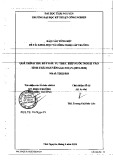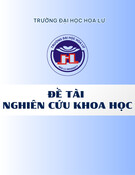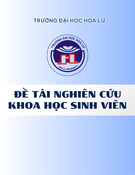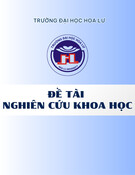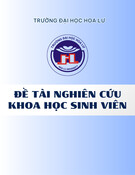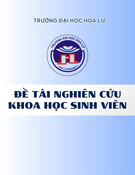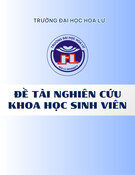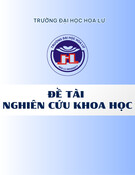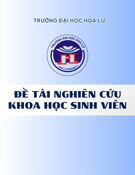
Project Title
Code: 1.11
Enhancing the capacity of Vietnam to reduce the losses of
grain and grain quality in storage through improved training
Australian Personnel Dr George Srzednicki
Dr Barry Longstaff
Australian Institution University of New South Wales (UNSW)
Vietnam Institution Sub. Post-Harvest Technology Institute in HCM city
Plant Protection Department, MARD
Project Duration July 2000 to June 2002
Project Description
This project will enhance the capacity in Vietnam to 'train the trainers', extension workers
and staff responsible for the maintenance of quality of commodities during storage and
marketing.
PHTI will provide flexible integrated courses on various aspects of post-harvest
commodity quality management, with particular attention to containment and loss
reduction. The training group will also be able to develop new training modules
applicable to contaminant reduction in fruit and vegetables as strategies for monitoring
and management of contaminants in vegetables are further developed.
Objectives
a) This project will establish an improved training infrastructure and to train trainers and
extension workers employed on the commodity storage environment
b) The project will alleviate the national shortage of skilled trainers in the post-harvest
domain and the problems that national and regional organisations face in training such
trainers effectively and efficiently.
c) The creation of a training centre in HCMC will allow the project to access the
greatest pool of Vietnamese expertise in training for post-harvest. The project will also
take regional issues into account, by conducting several training courses at three
important regional centres in the second year.

Outputs and Performance indicators
Outputs
Performance Indicators
♦ Establishment of a dedicated
training facility at PHTI and
HCMC, in the centre of Vietnam's
major area of production of
durable commodities. This
facility would focus in training
trainers in the commodity storage
environment.
i) Purchase of computers for the PHTI centre
ii) Purchase of portable gas detection equipment
for practical sessions on fumigation
iii) Development of training manuals and
additional CAL modules in Vietnamese and
English
♦ Conduct a series of training
courses for industry trainers,
combining the CAL approach with
conventional lecturers and
practical sessions
i) Conduct general course for 24 participants in
HCMC, Year 1
ii) Conduct specialised training course, in
parallel, on Fumigation, Drying and Mycology and
Mycotoxins, in HCMC, Year 1
iii) Conduct general courses for 20 participants in
Hanoi, Can Tho and Dak Lak, Year 2
iv) Conduct specialised training course, in
parallel, on Fumigation, Drying and Mycology and
Mycotoxins, in Hanoi, Can Tho and Dak Lak, Year
2
♦ Review of success of project and
formulate implementation and
maintenance strategies with PHTI
i) Produce implementation and maintenance
manual, including a consideration of application to
containment reduction and quality management
strategies for fruit and vegetables
ii) Incorporation of recommendations into the
final report to AusAID
♦ Accountability i) Produce interim reports to AusAID after 6,
12, and 18 months
ii) Produce final report within a month of
project's end
iii) Submit financial reports after 12 and 24
months acquitting the expenditure incurred

PROJECT COMPLETION REPORT
Executive Summary
The project had a single objective, to enhance the capacity of Vietnam to train trainers,
extension workers and staff responsible for the maintenance of quality of commodities
during storage and marketing. The project has been able to achieve or exceed all of its
original performance indicators, despite major budgetary problems that arose as a result
of the significant decline in value of the Australian dollar early in the project. The project
has been able to establish a viable training infrastructure at the Post-harvest Technology
Institute (PHTI), in HCMC, by providing computers, gas detection equipment and
Computer-Assisted Learning (CAL) system. In order to address the budgetary issues, it
was necessary to reduce the number of courses involving Australian personnel. A total of
102 people participated in these courses but, with additional people trained independently
by PHTI and the Plant Protection Department (PPD), the total increased to over 300,
almost double the original projection of 168. As PHTI had to limit numbers of
participants in training courses, due to the limited number of computers available, there is
clearly a considerable demand for training in this discipline. The participants ranged from
commercial fumigators to university lecturers and included a high proportion of women.
The activities of the Vietnamese collaborators have, therefore, more than compensated
for the negative effects of the budgetary problems stemming from the exchange rate
problems. The activities of our Vietnamese collaborators are very significant and indicate
their appreciation of the potential of the technology that they have been provided with by
the project. As the project progressed, staff from PHTI and PPD assumed increasing
responsibility for conduct of training courses and, by the end of the project, they were
running courses without Australian input. PHTI and PPD have indicated that they will
use the system on an even greater scale in the years to come.
One issue that arose in the final review of the project, which should be considered by
AusAID, was the need to develop a maintenance policy for the CAL software system.
Technologies and protocols will change over time, and the CAL system will need to be
updated to reflect these changes. The review committee thought that a workshop,
conducted every 2 or 3 years would be able to address this issue. Funding would be
needed to facilitate this workshop and the subsequent process of incorporating new
information.
1. Project Description
Background and preparation
In Vietnam, the average annual paddy loss is 13-16%, equivalent to about 1.6Mt of
harvested rice, valued in excess of AUS$500 million. About a quarter of these losses
occur in storage. Significant losses in quality also occur, in addition to these quantitative
losses. The potential savings from preventing a 0.5% weight loss by improving the
technical capability of the pest control workforce are thus considerable. The reduction in
weight loss, achieved through improved implementation of storage practices, required to
give a 10% return on the resources invested in this project is very small and is certainly
much less than 0.5%.

By late 1999, a collaborative project between Indonesia, Philippines, Thailand, Vietnam
and Australia developed a Computer-Assisted Learning (CAL) system to augment
conventional training methods. The package encompasses most important issues facing
staff involved in management of quality of grain in storage: grain drying, moulds and
mycotoxins, and pests. The package was integrated with conventional lectures and
practicals in training courses that were conducted in each country. Each course was
conducted primarily in the local language. A review of the success of the Vietnamese
component of this project, carried out with senior management of PHTI, concluded that
the project had been very successful and had demonstrated considerable potential. They
also recognised that this training approach would have further application in
implementation of contaminant reduction and quality management strategies for fruit and
vegetables. Factors limiting the widespread adoption of the technology in Vietnam
include a shortage of suitable computer hardware and the need to train trainers in further
development of new training modules and use of the package.
Adoption and integration of the CAL-based training system into the training regimes of
the participating organisations will lead to more effective training programs, particularly
as they have geographically-distributed workforces. There will also be substantial cost
savings for training programs. This will contribute to improvements in technology
transfer and training in the agricultural sector and, ultimately, to improved overall food
security, through reduced losses of vital food grains, leading to general improvements in
living standards. The more efficient use of chemical control measures will also reduce the
environmental impact of such measures.
By enhancing the capacity of PHTI, PPD and UAF to train trainers and personnel
involved in the management of commodity quality during storage, a wide range of groups
will derive direct benefits, including: commodity processing and storage units,
commodity export agencies, extension officers, and farmers associations. The project is
perceived by the Vietnamese as being of particular benefit to local women, who have
taken a great part in the management of agro-products quality during storage and
processing.
Lead Institution
The Department of Food Science and Technology of the University of NSW has a long
track record of successful collaboration with the Vietnamese organisations involved in
the project. Work with the University of Agriculture and Forestry, in Ho Chi Minh City
(UAF) began in 1993, with joint research work on the introduction of two-stage drying
system for grain to Vietnam, ACIAR-funded project, PHT/1990/006 (Applications of in-
store drying in the grain industry in South-East Asia), a project that also involved
Thailand and the Philippines. This project was completed in 1997 and led to collaboration
with PHTI, in Ho Chi Minh City, on detection of aflatoxin in maize and training of staff
in the feed-mills in this area. Mr. Nguyen Le Hung, from UAF, was awarded a PhD
scholarship from ACIAR in 1995 and he spent four years in the Department of Food
Science and Technology of the UNSW working on the development of a continuous
spouted-bed dryer. In 1998-99, a project (ACIAR project PHT/1997/131 (Computer-
Assisted Learning as a tool to improve storage pest management in key ASEAN
countries), jointly-funded by ACIAR and the AusAID APEC Support Program, enabled

UNSW to contribute a module on grain drying to the development and delivery of a
computer assisted learning package. A demonstration training course was conducted, at
PHTI, HCMC, in November, 1999.
Vietnamese partner institutions
The Post-Harvest Technology Institute
The Post-Harvest Technology Institute (PHTI) in HCMC, an institute within the Ministry
of Agriculture and Rural Development (MARD), is responsible for research, training and
extension for storage and processing of agricultural produce after harvest in Vietnam.
They also operate the Food Commodity Control Centre, which is responsible for
monitoring and quality certification of export produce. In the past, PHTI has collaborated
with Universities, the Extension Department of the Ministry of Agriculture and Rural
Development and with Australian agencies to organise training courses on aspects of
grain storage and processing for staff of agricultural trading companies, the Plant
Protection Department, the Department of National Reserve, and Universities from
throughout Vietnam. Most recently, it has been involved with CSIRO Entomology and
UNSW to develop a new computer-assisted learning system to improve training methods
(ACIAR Project PHT/1997/131).
Plant Protection Department
The Plant Protection Department (PPD) is the government institution responsible for
regulatory and quarantine security aspects of plant protection in Vietnam. Their role
includes pest management and situation forecasting, conduct of treatment measures, plant
quarantine and fumigation management, including the licensing of fumigators in
Vietnam.
The University of Agriculture and Forestry
The University of Agriculture and Forestry, in Ho Chi Minh City, trains both
undergraduates and graduates in varied branches of Agriculture and Forestry. The
University also has strong reputation for scientific research. The Department of
Processing and Conservation of Food and Agricultural Products of the University is
particularly strong and has collaborated with Australia (UNSW) and other countries in
research on grain dryers, with results that are being widely applied in the production
field.
1.2 Context and rationale
Agricultural production is very important source of export income for Vietnam and over
70% of people living in rural areas are involved in agricultural production. Agricultural
products constitute about 40% of Vietnam’s gross national product and, in 1998, they
exceeded AU$ 6 billion in value, more than twice the value of that exported only 8 years
previously. Almost 90% of this export income was derived from rice and 80% of the
balance from coffee.
In Vietnam, management of quality of durable commodities whilst in storage is relatively
underdeveloped and downgrading in quality of agricultural products, as a consequence of
insect infestation, fungal spoilage, or presence of unacceptable levels of pesticide
residues, is very common. Post-harvest grain losses in ASEAN region countries can be



![Báo cáo seminar chuyên ngành Công nghệ hóa học và thực phẩm [Mới nhất]](https://cdn.tailieu.vn/images/document/thumbnail/2025/20250711/hienkelvinzoi@gmail.com/135x160/47051752458701.jpg)



